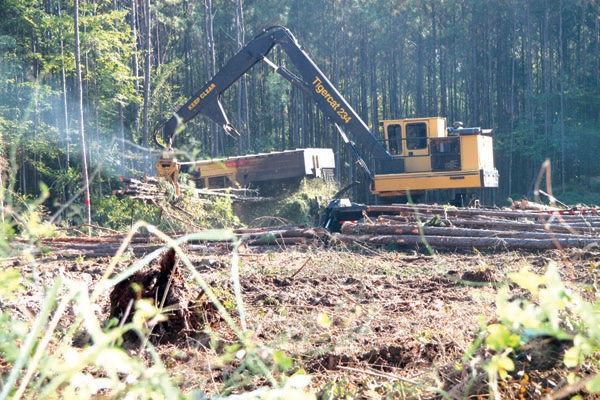
Mississippi forestry equipment show features in-the-field demonstrations
Several thousand equipment dealers, loggers, and representatives from a wide array of forest industry businesses came to the Mid-South Forestry Equipment Show at Starkville, Miss., for in-the-woods equipment demonstrations, static displays, and entertainment.It is the oldest outdoor, live logging demonstration event in the nation where equipment manufacturers can operate their equipment under actual field conditions.

It is every red-blooded, big-machinery-lovin’ guy’s dream — monster machines with huge tires, plowing through the mud of the forest, roaring and clanking as they fell trees, move them about with giant arms, and effortlessly chew limbs, spitting sawdust and chips as they go.
This year’s two-day Mid-South Forestry Equipment Show, held biennially on Mississippi State University’s 8,500-acre John W. Starr Memorial Forest, drew several thousand equipment dealers, loggers, and representatives from a wide array of forest industry businesses for in-the-woods equipment demonstrations, static displays, and entertainment.
It is the oldest outdoor, live logging demonstration event in the nation where equipment manufacturers can operate their equipment under actual field conditions. The show has been in operation for 29 years, providing a grass roots technology transfer between loggers, foresters, and equipment manufacturers.
While the housing downturn of recent years has put a crimp in the forest products industry, timber and timber products continue to be a major contributor to Mississippi’s economy, says James Henderson, assistant Extension professor of forestry at Mississippi State University.
“For 2011, the harvest value for Mississippi forest products was $1.4 billion,” he says. “That was a decline of less than 1 percent from 2010, but was 19.7 percent higher than the $864.9 million value in 2009 — an exceptionally poor harvest year.”
Several sawmills in the state closed in 2011, and a few changed ownership, but there were still more than 100 hardwood and softwood sawmills in operation statewide.
That is only about a third the number of mills in operation in the 1990s, notes David Jones, assistant Extension professor forest products at Mississippi State University. Much of the decline in numbers has been the result of increased efficiency and older mills being decommissioned, he says.
“Of the mills in operation in 2011, most were running below capacity,” he says, “but they’re holding on, waiting for the economy to recover.”
The Mississippi Forestry Commission notes that the state ranks No. 1 in the nation in the number of Certified Tree Farms, with more than 3,200. Timber is an important agricultural crop in the local economy of virtually every Mississippi county outside the Delta. In any year, it will be among the top three most valuable agricultural crops in 65 to 70 of the state’s 82 counties. The state has almost 20 million acres of forest land, and about 65 percent of its land area is in forests. Of that, 46 percent of the acreage is in hardwoods, 39 percent in pines, and 15 percent in mixed oak and pine.
In addition to timber and timber products, the commission points out that the state’s forests also provide a wide range of recreational opportunities, foster tourism, and create environmental benefits such as water quality, cleaner air, improved wildlife habitat, and storage of atmospheric carbon.
Seventy percent of the state’s forest land is held by private landowners, many of them farmers; 18 percent is government owned; and 12 percent is owned by forest industry companies.
The value of the state’s timber harvest has exceeded $1 billion each year since 1993, reaching an all-time record $1.45 billion in 2005. Since about 1988, timber has ranked first or second in production value in the state; in 2007, it was the second leading agricultural product in the state behind poultry.
The total industry output of Mississippi’s forest products industry generates an economic impact of $17.4 billion annual and the forest products industry accounts for $7.1 billion annually in value-added economic impact for the state.
The Mississippi forest products industry contributes to 8.3 percent all jobs in the state; an estimated 123,659 full-time or part-time jobs have their roots in the industry. In terms of wages and salaries paid, the industry generates a statewide economic impact of $4.4 billion.
About the Author(s)
You May Also Like



